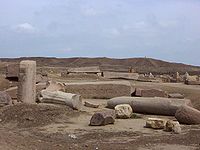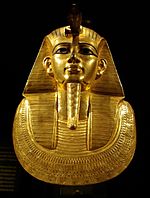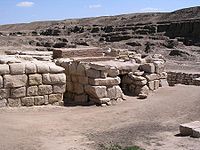- Tanis
-
For other uses, see Tanis (disambiguation).
Tanis (Τάνις), the Greek name of ancient Djanet (modern صان الحجر Ṣān al-Ḥaǧar), is a city in the north-eastern Nile delta of Egypt. It is located on the Tanitic branch of the Nile which has long since silted up.
Contents
History
Tanis was founded in the late Twentieth Dynasty,[citation needed] and became the northern capital of Egypt during the following Twenty-first Dynasty. It was the home city of Smendes, founder of the 21st dynasty. During the Twenty-second Dynasty Tanis remained as Egypt's political capital (though there were sometimes rival dynasties located elsewhere in Upper Egypt). It was an important commercial and strategic city until it was threatened with inundation by Lake Manzala in the 6th century AD, when it was finally abandoned. The refugees founded the nearby city of Tennis.
Ruins
There are ruins of a number of temples, including the chief temple dedicated to Amun, and a very important royal necropolis of the Third Intermediate Period (which contains the only known intact royal Pharaonic burials — the tomb of Tutankhamun having been entered in antiquity). Many of the stones used to build the various temples at Tanis came from the old Ramesside town of Qantir (ancient Pi-Ramesses/Per-Ramesses), which caused many former generations of Egyptologists to believe that Tanis was, in fact, Per-Ramesses. However the burials of three Dynasty 21 and Dynasty 22 pharaohs — Psusennes I, Amenemope and Shoshenq II, survived the depredations of tomb robbers throughout antiquity. They were discovered intact in 1939 and 1940 by Pierre Montet and proved to contain a large catalogue of gold, jewelry, lapis lazuli and other precious stones including the funerary masks of these kings.
The chief deities of Tanis were Amun, his consort, Mut, and their child Khonsu, forming the Tanite triad. This triad was, however, identical to that of Thebes, leading many scholars to speak of Tanis as the "northern Thebes".
In 2009, the Egyptian Culture Ministry reported archaeologists had discovered the site of a sacred lake in a temple to the goddess Mut at the San al-Hagar archaeological site in ancient Tanis. The lake, built out of limestone blocks, had been 15 meters long and 12 meters wide. It was discovered 12 meters below ground in good condition. This was the second sacred lake found at Tanis. The first lake at the site had been identified in 1928.[1]
In popular culture
In the film Raiders of the Lost Ark, Tanis was said to be the resting place of the Ark of the Covenant which was hidden in a secret chamber. Tanis was inaccurately depicted as having been destroyed in a sand storm and buried until 1936 when it was discovered by a German expedition outside Cairo. In fact, Tanis was the site of numerous archaeological digs beginning in the 19th century, involving Flinders Petrie and Auguste Mariette.
References
- ^ Johnston, Cynthia. Pharaonic-era sacred lake unearthed in Egypt. Reuters, October 15, 2009.
![I10 [D] D](/pictures/enwiki/57/90px-General_Wendjebauendjed_mask.jpg)
![D36 [a] a](/w/extensions/wikihiero/img/hiero_D36.png)
![N35 [n] n](/w/extensions/wikihiero/img/hiero_N35.png)
![X1 [t] t](/w/extensions/wikihiero/img/hiero_X1.png)

![N35A [mw] mw](/w/extensions/wikihiero/img/hiero_N35A.png)


![O49 [niwt] niwt](/w/extensions/wikihiero/img/hiero_O49.png)
or ![I10 [D] D](/w/extensions/wikihiero/img/hiero_I10.png)
![D36 [a] a](/w/extensions/wikihiero/img/hiero_D36.png)
![N35 [n] n](/w/extensions/wikihiero/img/hiero_N35.png)
![X1 [t] t](/w/extensions/wikihiero/img/hiero_X1.png)
![O49 [niwt] niwt](/w/extensions/wikihiero/img/hiero_O49.png)
Djanet (ḏˁn.t)
in hieroglyphs- Association française d’Action artistique. 1987. Tanis: L’Or des pharaons. (Paris): Ministère des Affaires Étrangères and Association française d’Action artistique.
- Brissaud, Phillipe. 1996. "Tanis: The Golden Cemetery". In Royal Cities of the Biblical World, edited by Joan Goodnick Westenholz. Jerusalem: Bible Lands Museum. 110–149.
- Kitchen, Kenneth Anderson. [1996]. The Third Intermediate Period in Egypt (1100–650 BC). 3rd ed. Warminster: Aris & Phillips Limited.
- Montet, Jean Pierre Marie. 1947. La nécropole royale de Tanis. Volume 1: Les constructions et le tombeau d’Osorkon II à Tanis. Fouilles de Tanis, ser. ed. Jean Pierre Marie Montet. Paris: .
- ———. 1951. La nécropole royale de Tanis. Volume 2: Les constructions et le tombeau de Psousennès à Tanis. Fouilles de Tanis, ser. ed. Jean Pierre Marie Montet. Paris: .
- ———. 1960. La nécropole royale de Tanis. Volume 3: Les constructions et le tombeau de Chechanq III à Tanis. Fouilles de Tanis, ser. ed. Jean Pierre Marie Montet. Paris.
- Stierlin, Henri, and Christiane Ziegler. 1987. Tanis: Trésors des Pharaons. (Fribourg): Seuil.
- Yoyotte, Jean. 1999. "The Treasures of Tanis". In The Treasures of the Egyptian Museum, edited by Francesco Tiradritti. Cairo: The American University in Cairo Press. 302–333.
-
Wendebauendjed's funerary mask
-
Pharaoh Osorkon II's tomb at Tanis
External links
- Tanis (San-el-Hagar)
- Archaeology Magazine article on Teasures of Tanis
- Tanis: San el-Hagar
- Tanis in Encyclopaedia of the Orient
- Travel information for Tanis
Preceded by
ThebesCapital of Egypt
1078 BC–740 BCSucceeded by
SaisAncient Egypt 
Architecture · Art · Burial customs · Chronology · Cuisine · Dynasties · Geography · History · Literature · Mathematics · Medicine · Military · Music · Religion · Pharaohs (list) · People · Language · Sites · Technology · Writing
Egyptology · Egyptologists · Egyptian MuseumCategories:- Ancient Greek sites in Egypt
- Archaeological sites in Egypt
- Populated places in Egypt
- Hebrew Bible cities
- Former populated places in Egypt
- Nile River Delta
Wikimedia Foundation. 2010.





